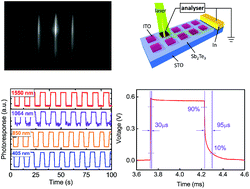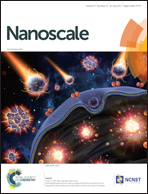Broadband ultrafast photovoltaic detectors based on large-scale topological insulator Sb2Te3/STO heterostructures†
Abstract
Topological insulators (TIs) are new states of quantum matter in which the spin-momentum-locked surface states reside in the bulk insulating gap and have triggered extensive investigations on fundamental properties and potential applications. Herein, we report scalable, broadband photovoltaic detectors based on the topological insulator Sb2Te3/strontium titanate (STO) heterostructure. Large-scale (2 mm × 5 mm), high crystalline quality p-type Sb2Te3 films were fabricated on an n-type STO substrate by the molecular beam epitaxy (MBE) method. The Sb2Te3/STO heterostructures exhibited pronounced photovoltaic behavior in a wide range of temperatures as a result of a strong built-in field at the hetero-interface. Superior performances of broadband (from visible to infrared, 405 nm–1550 nm) and ultrafast (rise time ∼30 μs, fall time ∼95 μs) photoresponses were achieved under ambient conditions. The prominent repeatability and stability indicated that our photodetectors can operate effectively in harsh circumstances. These results show that stacking the topological insulator thin films on a strongly correlated oxide substrate using the MBE approach holds great promise for high performance optoelectronic applications.



 Please wait while we load your content...
Please wait while we load your content...